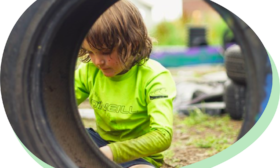LEARNING PATHWAY BASED ON SCIENTIFIC CONCEPTS
Circular Economy
Overall aims:
- Explore the concept of a Circular Economy;
- Explore the concept of a Linear Economy;
- Explore designing out pollution and waste;
- Explore keeping materials in use;
- Explore regenerating natural systems;
- Develop understanding of systems that support a circular economy.
Intended learning outcomes:
The child will be able to:
- Explain the benefits of designing out waste and pollution;
- Explain the benefits of keeping materials in use;
- Explain the benefits of regenerating natural systems;
- Be entrepreneurial in their approach to participating in a circular economy.
Evaluation:
To rigorously evaluate the Learning Path, the teacher and children need to document the entire process, from the very first discussion. Encourage the children to be documentarians. Ask a child to interview others on the effectiveness of the Learning units.. Using video or audio and visual stills is ideal. The teacher can then lead the children in the editing process, whether it is a hard copy Learning Story/Scrapbook or an edited video. The editing process will help the teacher and the children revisit and examine the data more closely in order to be able to make informed decisions on moving forward with the learning path.
While looking at the data gathered by the teacher and the children, the teacher will work with the children’s natural tendency to question and encourage them to fine tune their questioning methods towards Socratic Questioning so that the discussion is thoughtful, focused and retains interest.
While the Learning Path focuses on the Circular Economy which mainly highlights the economic and ecological pillars of sustainability, the Path is designed so that it incorporates the social pillar as well, when it considers the social cost of a linear economy. While this learning is incidental, at the time of evaluation, the teacher highlights this learning to the children and asks, “What else can we do? What else can we do to ensure that the people who make clothes, cars, computers, phones, toys are treated fairly as workers? ” This aims to support entrepreneurial thinking.
While examining the data, the teacher cross references the documented learning with sustainability skills as well as STEAM skills. In this Learning Path, there were opportunities for mathematical thinking, chemical explorations, engineering and entrepreneurship. What worked? What didn’t? What unexpected opportunities arose and what was overlooked?
Pathway structure:
This learning path starts at the autumnal equinox and continues till the summer solstice. The long term projects incorporated into this learning path, the Repair Cafe and the Restoration Yard, are set around the Autumnal Equinox and are developed, altered and fine tuned over the year. The Waste-Not Clothes Swap takes place between Samhain (November 1st, the midway point between the Autumnal Equinox and the Winter Solstice). The Fiestas take place at both Equinoxes and Solstices. In this first learning unit, the children explore the differences between a using materials in a linear economy; buy things, break them and throw them away and a circular economy: you things, take care of them, maintain them and repurpose them.
Stage I – Repair Cafe
This learning unit seeks to demonstrate how we can keep materials in use in a circular economy. The teacher leads discussions with children about how they perceive their toys and learning materials. The idea here is to encourage children, parents and educators, to regard the things we use everyday like toys, clothes as valuable precious materials as opposed to disposable objects that we can use up and throw away.
- Repair Cafe – Plan and design a systemized repair cafe to restore materials for projects
Stage II – Restoration Yard
The second activity seeks to demonstrate how a circular economy works in a practical way and hot it produces less waste and pollution than a linear economy.
- Restoration Yard – Plan and design a systemized Restoration Yard to preserve materials for projects and participate in a circular economy that values materials and keeps them in use instead of in the “recycling” bin
Stage III – Keep It Clean
While Unit 1 and 2, seek to demonstrate how a circular economy works in a practical way and how it produces less waste and pollution than a linear economy, Unit 3, Keep It Clean aims to extend upon keeping materials in use.
- Keep It Clean – Create environmentally friendly cleaning products
Stage IV – Waste-Not Clothes Swap
The goal of this unit is to address the complicated, sensitive subject of fast fashion. This is a delicate topic for many families so the teacher needs to approach this task carefully, without assumptions or judgment. It is arguably an unavoidable subject for any educators who want to support sustainability skills seeing that fast fashion is prevalent and is the direct opposite of a circular economy and sustainable practices. The goal of this unit is to help children maintain a balance of treating their clothes with respect without being precious or worrying about them.
- Waste-Not Clothes Swap – Designing and creating a short video to showcase class projects
Stage V – No Waste Autumn Fiesta!
The goal of this unit is to demonstrate that adhering to a circular economy not only reduces waste, is less harmful to the environment and saves funds but it can be fun and beautiful too. Birthday parties and other celebrations often lead to several bags full of waste that can’t be recycled. Getting into the habit of throwing parties without using convenient disposable materials takes some getting used to but if approached with a sound plan, can be joyful and exciting.
- No Waste Autumn Fiesta! – Design, plan, host a no waste gathering with the aim to regenerate a natural system by planting pollinator supporting bulbs that will bloom in Spring









